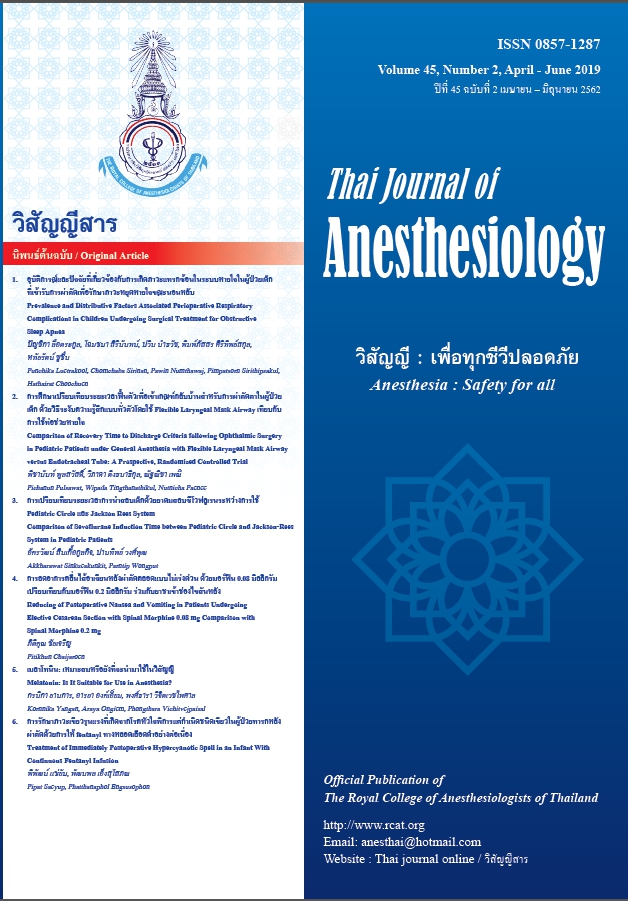Prevalence and Distributive Factors Associated Perioperative Respiratory Complications in Children Undergoing Surgical Treatment for Obstructive Sleep Apnea
Main Article Content
Abstract
Background: Complications in surgical treatment for
obstructive sleep apnea (OSA) are rare events but most
of the complications are related to respiratory system.
Therefore, this study was conducted to find out that anesthetic
techniques were affected respiratory complications in
these circumstances.
Objective: To survey the prevalence and distributive
anesthetic factors associated perioperative respiratory
complications in pediatric patients who underwent surgical
treatment for OSA.
Methods: A retrospective cohort study was conducted in
patients aged 5-15 year who underwent surgical treatment
for OSA under general anesthesia from January 2013 to
December 2014.
Results: There were 314 patients undergoing tonsillectomy,
adenoidectomy, and adenotonsillectomy for treatment
OSA. One hundred and sixty-five patients were included
in this study. Nine cases (5.45%) had postoperative
respiratory complications. We also analyzed the risk factors
of anesthetic agents and techniques used which did not
significantly cause perioperative respiratory complication.Conclusions: The most common perioperative complications
in surgical treatment for OSA are secretion obstruction and desaturation. These events seem not to be significantly
associated with any single anesthetic agent or regimen.
Article Details
References
Technical report: diagnosis and management of childhood
obstructive sleep apnea syndrome. Pediatrics 2002;109(4):
e69.
2. Statham MM, Elluru RG, Buncher R, Kalra M. Adenotonsillectomy
for obstructive sleep apnea syndrome in young children:
prevalence of pulmonary complications. Arch Otolaryngol
Head Neck Surg 2006;132(5):476-80.
3. Ye J, Liu H, Zhang G, Huang Z, Huang P, Li Y. Postoperative
respiratory complications of adenotonsillectomy for obstructive
sleep apnea syndrome in older children: prevalence, risk
factors, and impact on clinical outcome. J Otolaryngol Head
Neck Surg 2009;38(1):49-58.
4. Brown KA, Laferriere A, Lakheeram I, Moss IR. Recurrent
hypoxemia in children is associated with increased analgesic
sensitivity to opiates. Anesthesiology 2006;105(4):665-9.
5. Sanders JC, King MA, Mitchell RB, Kelly JP. Perioperative
complications of adenotonsillectomy in children with obstructive
sleep apnea syndrome. Anesth Analg 2006;103(5):1115-21.
6. Hill CA, Litvak A, Canapari C, et al. A pilot study to identify
pre- and peri-operative risk factors for airway complications
following adenotonsillectomy for treatment of severe pediatric
OSA. Int J Pediatr Otorhinolaryngol 2011;75(11):1385-90.
7. De Luca Canto G, Pacheco-Pereira C, Aydinoz S, et al.
Adenotonsillectomy Complications: A Meta-analysis.
Pediatrics 2015;136(4):702-18.


